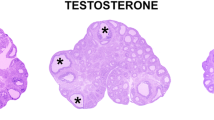Abstract
An experimental model of hyperandrogen-induced anovulatory infertility (s.c. implantation of Silastic capsules containing testosterone into adult female rats) was used to study morphological, hormonal, and biochemical measures characterizing the state of the hypothalamo-hypophyseal-ovarian system. Impairments in functional androgen metabolism in the hypothalamus were seen, with decreases in the Luliberin sensitivity of the hypophysis, changes in the structure of estral cycles, and morphological changes in the ovaries; these findings are evidence for neuroendocrine disturbances in the control of ovulation. Flutamide, an experimental antiandrogen, led to partial normalization of the hormonal, biochemical, and morphological characteristics, as well as to recovery of fertility in females with anovulatory infertility.
Similar content being viewed by others
REFERENCES
A. G. Reznikov and T. I. Korpacheva, Probl. Éndokrinol., No. 6, 65–71 (1985).
A. G. Reznikov, I. G. Akmaev, O. V. Fidelina, et al., Probl. Éndokrinol., 36, No. 3, 57–61 (1990).
D. E. Shilin, Probl. Éndokrinol., 38, No. 3, 31–35 (1992).
A. Balen, Probl. Éndokrinol., No. 4, 31–35 (1998).
C. F. Baraghini, M. F. Celani, A. A. Zaidi, et al., J. Endocrinol. Invest., 7, Suppl. 3, 23–31 (1984).
F. Bayram, I. I. Muderris, Y. Sahin, and F. Kelestimur, Exptl. Clin. Endocrinol. Diabet., 107, No. 3, 195–197 (1999).
M. V. van Damme, D. M. Robertson, and E. Diczfalusy, Acta Endocrinol., 77, 655–663 (1974).
D. A. Ehrmann, R. B. Barnes, and R. L. Rosenfield, Endocrinol. Rev., 16, No. 3, 322–353 (1995).
L. Falsetti and A. Gambera, Fertil. Steril., 72, No. 1, 41–46 (1999).
C. Flamigni, S. Venturoli, B. Ravaioli, et al., The Ovary: Regulation, Dysfunction and Treatment, Amsterdam (1996), pp. 353–361.
P. Harms and S. R. Ojeda, J. Appl. Physiol., 36, 391–392 (1974).
D. F. M. Loke, S. S. Ratman, and H. H. Goh, J. Neuroendocrinol., 4, No. 2, 211–215 (1992).
M. Marugo, D. Bernasconi, M. Meozzi, et al., J. Endocrinol. Invest., 17, No. 3, 195–199 (1994).
R. S. Rittmaster, Endocrinol. Metab. Clin. N. Amer., 28, No. 2, 409 (1999).
A. Weissman, A. Barash, and Z. Shoham, The Ovary: Regulation, Dysfunction and Treatment, Amsterdam (1996), pp. 425–436.
Author information
Authors and Affiliations
Rights and permissions
About this article
Cite this article
Reznikov, A.G., Sinitsyn, P.V., Tarasenko, L.V. et al. Neuroendocrine Mechanisms of Development of Experimental Hyperandrogen-Induced Anovulation. Neurosci Behav Physiol 33, 773–776 (2003). https://doi.org/10.1023/A:1025141130241
Issue Date:
DOI: https://doi.org/10.1023/A:1025141130241




